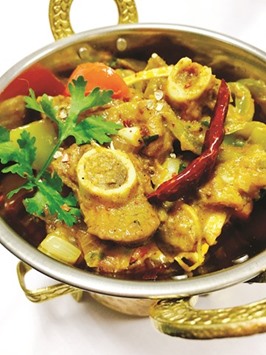Until recently, Indian food had always been associated with rich curries hailing from the kitchens of kings and nawabs of wealthy states or with the “fiery hot” fare run by the mill restaurants.
But Indian food has its roots deep in the cuisine calendar of yesteryears. It has its own unique cooking techniques, method of cooking and each preparation has its own history and significance. Indian cuisine has passed through a refinement in the last century and its association with just these rich curries and chili hot fare is no longer justified.
I am sure about two things: Indian cuisine can be vastly elaborate, and that Indian hospitality is overwhelming. The most commonly used utensils in Indian cuisine are kadhai, handi and tawa. Kadhai is a deep, spherical, circular cooking pot with two handles used in India, Pakistan and Bangladesh, handi is deep straight walled cooking utensil used for slow simmering dishes, and tawa is a large, flat concave or convex shaped hot plate used mainly for cooking the variety of breads.
In this article I will be elaborating the evolution and significance of Kadhai Cuisine. Originally there were two main dishes associated with kadhai cooking, namely Kadhai Gosht (lamb) and Kadhai Murgh (chicken). These dishes were particularly popular in undivided India in the areas of Peshawar and Punjab, now in Pakistan.
Kadhai is traditionally made out of cast iron although copper and brass versions were also available. Stainless steel kadhai is the latest addition to the choice of metal used to make kadhai and non-stick and induction variants are also available nowadays.
The local restaurants in these provinces featured kadhai shops that had an attached butchery and customers would order the dish according to their preference. The dish was prepared in the kadhai and was presented on the table, served with naan bread. Based on the original dish of chicken and mutton, an entire arrays of vegetable dishes are also prepared now by using the same cooking method and spices to please vegetarians.
Kadhai cooking is very similar to wok cooking in the Chinese cuisine, and is considered a fast method of cooking except for mutton, which has to be 3/4th pre-cooked before being cooked in the kadhai. In kadhai cooking, the main ingredient is continuously stirred and tossed with thick onion and tomato masala and finished with garam masala. There is hardly any water used in Kadhai Cuisine and the meat is cooked with onion tomato and its own juices.
While cooking, the sides of the kadhai are continuously scrapped and added to the dish for better flavour. This is very important as the masala or the gravy that dries up in the sides has a nice smokey and robust flavour, which helps enhance the overall taste of the dish. Also I would say cast iron is the best option for Kadhai Cuisine, as iron also enhances the taste of the ingredients cooked in it.
This classic yet simple dish is one of my favourites. It is traditionally cooked and even served in a kadhai. Serve Kadhai Gosht with hot chapati (Indian flatbread) or naan (tandoor baked Indian flatbread) and sliced onion on side as a salad for a perfect meal.
Mutton Kadhai
Ingredients (serves 2)
Mutton 600gm
Tomato, chopped 4 no
Onion paste 1 cup
Garlic paste 1 tbsp
Ginger 1 tbsp
Bay leaves 2 no
Coriander seeds ½ tsp
Cumin seeds ½ tsp
Green chili 2 no
Yoghurt 1/3 cup
Coriander powder ½ tbsp
Red chili powder 1 tsp
Turmeric powder 1 tsp
Oil 3 tbsp
Salt to taste
Garam masala ¼ tsp
For Garnish
Coriander leaves few sprigs
Ginger julienne to garnish
Red chili whole 2 nos
Method
Heat oil in a kadhai and let it reach its smoking point; reduce the heat to bring down the temperature.
Add slit green chili, fry them lightly and remove them from oil and keep aside.
Add the washed and drained cubes of mutton with bone in the oil and fry them from all the sides to seal the juices and cook them in oil.
Remove the fried mutton pieces and keep aside.
In the remaining oil splutter cumin seeds and coriander seeds, followed by bay leaf, ginger garlic paste and onion paste.
Saute till the raw flavour of garlic evaporates; add tomatoes and the remaining spices like turmeric, red chili powder, coriander powder and salt.
Add the pre-cooked mutton pieces and continue to cook over low flame, cover with lid.
Scrap the sides of kadhai and add to the dish to enhance the flavour.
When the mutton is cooked add yoghurt and cook till you see the oil float on surface.
Cook till the mutton is coated with thick masala and is fully cooked.
Remove from flame, garnish with ginger juliennes, coriander sprig and fried reed chili, and serve hot with choice of tandoori bread.
Note: Instead of frying the mutton in oil you can also boil it with whole hot spices to remove excess fat from the dish and make it with less oil content. And vegetarians can replace mutton with cottage cheese and capsicum.

Mutton Kadhai. Photo by the author


